|
Making a Local Calendar:
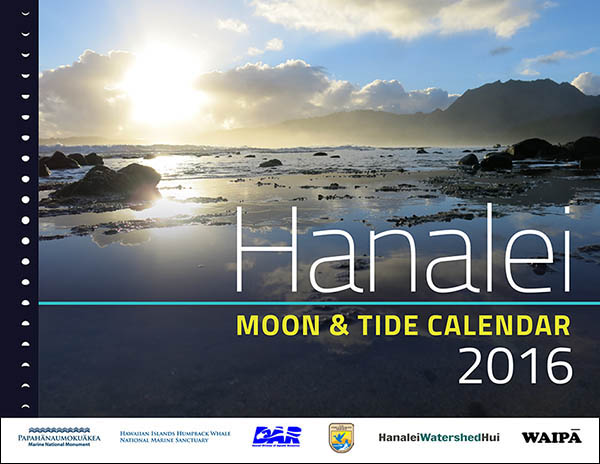
Cover of the 2016 Hanalei Calendar.
“Makaala and Hanalei, they came out with their moon calendar, their own calendar,” Presley says. “Ideally it would be good to have a somebody or a group that can manage the resources. The lunar calendar and the tide calendar are wonderful, but there are so many more other things that you cannot predict, like the climate.”
“The month names were different everywhere,” Carlos points out. “I’m sure they shared month names, but if you look at the definitions of the different months, it’s like ‘when the sea is loud and boisterous.’ So if you live on the north side of the island, that happens during our what we would we call winter. And if you live on the south side of the island, it happens during what we call summer, so who knows? Nobody really knows.”
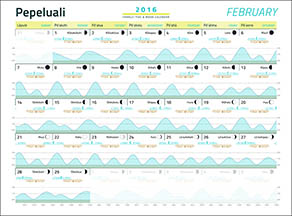
A sample page of the calendar showing moon and tide.
"Mac Poepoe on Moloka‘i did the first one,” Makaala says, “with some help from a man by the name of Paul Bartrum and Alan Friedlander who is preeminent ichythologist. And they put together the moon and tide calendar from Mo‘omomi, and we all looked at and went, 'Whoa! this about this place, that’s very cool.' This is about this place, this is about the critters of this place, because his premise was and is, the spawning calendar and schedule for the critters of his place are different than any other place.
"We have the fishing regulations that the state publishes, and they acknowledge that it’s an average for the whole state. It’s so wrong for most of us—it doesn’t help us at all! Because when you’re supposed to be protecting something, you’re not. And when you don’t need to protect it, you are.
“Our fisherman throw the thing in the rubbish because it doesn’t have anything to do with what they see in the sea—it just doesn’t. So how do you resolve that? You start catching fish and you start looking at the gonads and you determine when that fish in your place spawns, and then you say, ‘this is when you rest them—this is when you don’t catch that fish, you let that fish spawn,’ because what do you want? You want more fish, right? That’s the deal everybody can agree we want more fish, right. So the way to do that is with a moon and tide calendar.
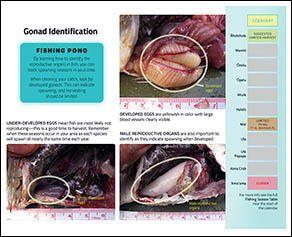
A page in the calendar explains gonad identification.
“So for Hanalei I said, 'Fisherman, you go catch the fish, I’ll clean your fish for free.’ We’ll, they’re not going to let this chickadee clean their fish for free, so it was a little bit of hard sell, but they let the kids do it, right. I’ll clean the fish because I want to do the gonads.
"It’s a simple issue: you take a picture of the fish, you measure the fish, you open the fish, you take a pictures of the gonads, you remove the gonads, you weigh the gonads, you record all that data—the date and the time and the moon—and you start collecting that and that turns into a fishing calendar, a spawning calendar.
“It turns out that the manini, one of our favorite little fish to eat for dinner—because they are easy to catch—spawn at one time on the eastern side of Hanalei Bay, and another time on the western side of Hanalei Bay. This is one bay. So between this shore and Hā‘ena—you know, five or six miles down the road—is vastly different. In every area it’s different. So how do you reconnect people with your place?
“One of the success stories of Hā‘ena is that they never lost the connection with their place. It was loose, but it wasn’t lost, it wasn’t broken. The connection to that land empowers them and enables them to do what they do. When you get the fisherman thinking the same way, because the fisherman was a different gang than the land guys that were doing the taro, right?
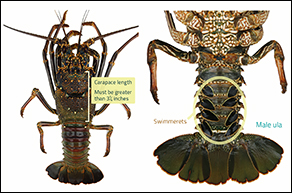
An explanation is provided on identifying male and female ula—Hawaiian lobsters—and how large the harvested males should be.
“You get the fisherman to do their thing and start to recognize what they had and when they should be resting them and how they could create more, and how they could take care of their fisheries. Hawaiians were not fisherman, they were farmers of the sea. They grew things in the sea, they planted things in the sea, they harvested things in the sea, but they farmed fish. They didn’t just go fish without making more fish, they never did.
“So we started to develop the process and work on its content for Hanalei and I said, “So, fisherman, you want me to make a small one. You can just put them in your pocket.' 'No I don’t have my glasses. I want a big calendar, I want a regular calendar and I’m going to put in the dashboard of my truck so I can open.” I said, 'Okay, do you want it on water proof paper?' 'No, I’m not getting it wet, I want to put it on the dash of my truck, I’m not standing out in the ocean reading my calendar.' Okay, so all the bright ideas that I thought I had, that I could make this a better calendar. Turns out NO, they just want a calendar.
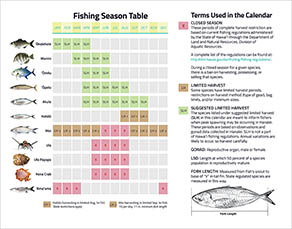
A table at the front of the calendar explains State of Hawai‘i fishing seasons.
“And their favorite part of this calendar is that this is the only calendar that has Hanalei tides. All the calendars on Kaua‘i use the Nawiliwili tides because it’s an easy formula to take off the Internet, you can get the information and you can put it on a calendar off the Internet, in a minute like that. But we actually give them Hanalei tides. And if you ask them around, what’s your favorite part—trust me this thing is full of fabulous information—they’re just so happy to have the tides. But we do talk about what to take and when.
“Each page of the calendar has what is limited at this time. We do show you what the gonads look like because people actually don’t know. This is not a Hawaiian calendar, this is a western calendar using Hawaiian terminology, because I said to the fisherman, you want a Hawaiian calendar—you know the months are not the same. You want a Hawaiian calendar? NO, we can’t read a Hawaiian calendar, we need the calendar we know how to read. Okay, so we’ll give you the Hawaiian names and all of that, but we’ll put it in a western monthly format. So someday they may change their minds, but at the moment, there are calendars in Hawai‘i now that use the Hawaiian format for a calendar, which is very confusing for people.”
|





